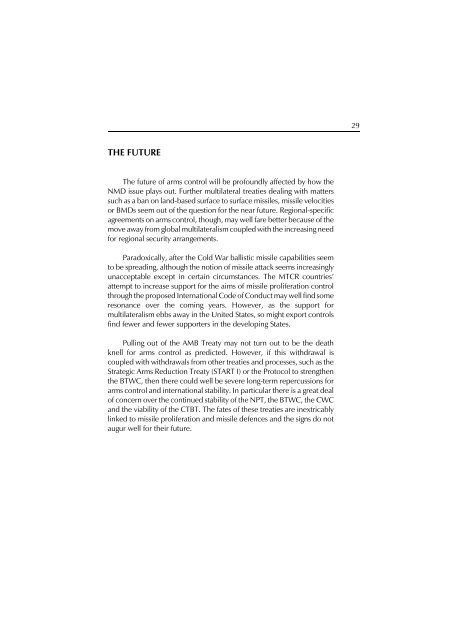Missile Defence, Deterrence and Arms Control - UNIDIR
Missile Defence, Deterrence and Arms Control - UNIDIR
Missile Defence, Deterrence and Arms Control - UNIDIR
You also want an ePaper? Increase the reach of your titles
YUMPU automatically turns print PDFs into web optimized ePapers that Google loves.
12<br />
threshold strike for which a midcourse system could be effective is<br />
estimated to be in the order of tens of missiles, or roughly China’s<br />
current ICBM arsenal. But even with an 80 per cent attrition<br />
rate—generous according to former Defense Secretary William Perry—a<br />
midcourse defence could become oversaturated at even lower<br />
thresholds.<br />
Fourth, a fixed ground-based midcourse system would leave key<br />
components such as the X-b<strong>and</strong> radars vulnerable to attack. A ballistic<br />
missile attack from any potential aggressor would most likely be<br />
preceded by some form of conventional strike against the system’s key<br />
detection <strong>and</strong> tracking components, rendering it impotent against the<br />
impending ballistic missile launch. Anecdotally, America’s early warning<br />
for an impending missile attack would be when a rain of missiles fell at<br />
Thule <strong>and</strong> Flyingdales.<br />
Finally, a midcourse ground-based system would only suffice to<br />
protect the United States homel<strong>and</strong>. The architecture for such a system<br />
would be a poor defence in theatres beyond the United States homel<strong>and</strong><br />
since ballistic missile flight times in those theatres would be short <strong>and</strong> the<br />
interceptors quite distant from the point of attack. Although a midcourse<br />
system would only protect the United States homel<strong>and</strong>, it could do so<br />
regardless of where the missile strike originated—it is not threat specific.<br />
Hence Russian <strong>and</strong> Chinese concern that any “limited” midcourse<br />
national missile defence, once the technology had been mastered, could<br />
easily be upgraded to defend against their existing arsenals. Clearly, once<br />
the United States is capable of deploying 100 interceptors to effectively<br />
intercept ballistic missiles in the midcourse phase, there is little to stop<br />
Washington from deploying 1,000 interceptors to defend against a<br />
Russian strike.<br />
Boost Phase Interception<br />
Because of the technical hurdles to targeting a ballistic missile in the<br />
midcourse of its trajectory, many experts are moving towards the<br />
consensus that pursuing a ballistic missile defence for the boost phase is<br />
the most feasible option. Two types of boost phase defences have been<br />
suggested: sea-based platforms, most likely on Aegis cruisers, <strong>and</strong><br />
airborne laser systems either on manned or unmanned aerial vehicles.








